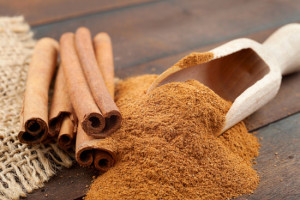Cinnamon is a spice that comes from the branches of wild trees that belong to the genus “Cinnamomum” – native to the Caribbean, South America, and Southeast Asia.
Contents
Uses
- Romans used cinnamon to make their strong, bitter wine palatable, Greeks to season meat and vegetable dishes, Arabs in tea, and nearly everyone in baked goods. English nobility hoarded to delicate Ceylon cinnamon to flavor breads and puddings. In America, what we know as cinnamon is usually Indonesian cassia (a close botanical relative of the true cinnamon tree).
Benefits
- The active principles in the cinnamon spice are known to have anti-oxidant, anti-diabetic, anti-septic, local anesthetic, anti-inflammatory, rubefacient (warming and soothing), carminative and anti-flatulent properties.
- Cinnamon spice has the highest anti-oxidant strength of all the food sources in nature. The total measured ORAC (Oxygen radical absorbance capacity) value for this novel spice is 2,67,536 trolex equivalents (TE), which is many hundred times more than in chokeberry, apples, etc.
- The spice contains health benefiting essential oils such as eugenol, a phenylpropanoids class of chemical compound, which gives pleasant, sweet aromatic fragrance to it. Eugenol has got local anesthetic and antiseptic properties, hence; employed in the dental and gum treatment procedures.
- Other important essential oils in cinnamon include ethyl cinnamate, linalool, cinnamaldehyde, beta-caryophyllene, and methyl chavicol.
- Cinnamaldehyde in cinnamon-sticks has been found to have anti-clotting action, prevents platelet clogging inside the blood vessels, and thereby helps prevent stroke, peripheral arterial and coronary artery diseases.
- The active principles in this spice may increase the motility of the intestinal tract as well as help aid in the digestion by increasing gastro-intestinal enzyme secretions.
- This spicy bark is an excellent source of minerals like potassium, calcium, manganese, iron, zinc, and magnesium. Iron is required for cellular metabolism as a co-factor and in RBC’s production. Potassium is an important component of cell and body fluids that helps control heart rate and blood pressure. Manganese and copper are chiefly used by the body as co-factors for the antioxidant enzyme, superoxide dismutase.
- It also contains very good amounts of vitamin A, niacin, pantothenic acid, and pyridoxine.
- Further, it is also a very good source of flavonoid phenolic anti-oxidants such as carotenes, zea-xanthin, lutein and cryptoxanthin.
Cautions
- Cassia cinnamon is LIKELY SAFE when used in amounts commonly found in foods and when taken by mouth in medicinal doses.
- Cassia cinnamon is POSSIBLY UNSAFE when taken by mouth in large amounts for a long period of time. Taking large amounts of cassia cinnamon might cause side effects in some people. Cassia cinnamon can contain large amounts of a chemical called coumarin. In people who are sensitive, coumarin might cause or worsen liver disease. When applied to the skin, cassia cinnamon can sometimes cause skin irritation and allergic skin reactions.
Interactions
-
- Medications for diabetes (Antidiabetes drugs) interacts with CASSIA CINNAMON
Cassia cinnamon might decrease blood sugar. Diabetes medications are also used to lower blood sugar. Taking cassia cinnamon along with diabetes medications might cause your blood sugar to go too low. Monitor your blood sugar closely. The dose of your diabetes medication might need to be changed.Some medications used for diabetes include glimepiride (Amaryl), glyburide (DiaBeta, Glynase PresTab, Micronase), insulin, pioglitazone (Actos), rosiglitazone (Avandia), chlorpropamide (Diabinese), glipizide (Glucotrol), tolbutamide (Orinase), and others.
- Medications that can harm the liver (Hepatotoxic drugs) interacts with CASSIA CINNAMON
Taking very large doses of cassia cinnamon might harm the liver, especially in people with existing liver disease. Taking large amounts of cassia cinnamon along with medications that might also harm the liver might increase the risk of liver damage. Do not take large amounts of cassia cinnamon if you are taking a medication that can harm the liver.Some medications that can harm the liver include acetaminophen (Tylenol and others), amiodarone (Cordarone), carbamazepine (Tegretol), isoniazid (INH), methotrexate (Rheumatrex), methyldopa (Aldomet), fluconazole (Diflucan), itraconazole (Sporanox), erythromycin (Erythrocin, Ilosone, others), phenytoin (Dilantin), lovastatin (Mevacor), pravastatin (Pravachol), simvastatin (Zocor), and many others.
- Medications for diabetes (Antidiabetes drugs) interacts with CASSIA CINNAMON
Other names
Bastard Cinnamon, Canela de Cassia, Canela Molida, Canelle, Cannelle Bâtarde, Cannelle Cassia, Cannelle de Ceylan, Cannelle de Chine, Cannelle de Cochinchine, Cannelle de Padang, Cannelle de Saigon, Cannelier Casse, Canton Cassia, Casse, Casse Odorante, Cassia, Cassia Aromaticum, Cassia Bark, Cassia Lignea, Chinese Cinnamon, Cinnamomi Cassiae Cortex, Cinnamomum, Cinnamomum aromaticum, Cinnamomum cassia, Cinnamomum ramulus, Cinnamon, Cinnamon Essential Oil, Cinnamon Flos, Cinnamoni Cortex, Cinnamonomi Cortex, Cortex Cinnamomi, Écorce de Cassia, False Cinnamon, Fausse Cannelle, Gui Zhi, Huile Essentielle de Cannelle, Keishi, Laurier des Indes, Nees, Ramulus Cinnamomi, Rou Gui, Sthula Tvak, Taja, Zimbluten
References
Nutrition and you, http://www.nutrition-and-you.com/cinnamon-spice.html
The spice house, http://www.thespicehouse.com/spices-by-category/cinnamon/

